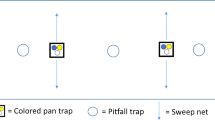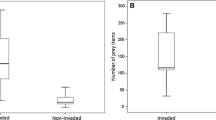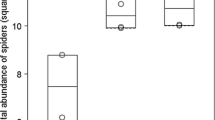Abstract
The artesian springs that are located on the edge of the Great Artesian Basin in arid South Australia support diverse assemblages of spiders. Domestic or feral stock have affected the vegetation and substrate of artesian springs, which are important water sources. The effects of stock on the spider communities of artesian springs were investigated with a descriptive survey, comparing springs with differing grazing histories, and with a field experiment that simulated the impacts of cattle presence with trampling and mowing treatments. In the survey, the abundance of spiders was associated with the dominant vegetation cover and with the history of grazing pressure. In the experiment, the abundance of web-building and ambush-hunting spiders declined following mowing and/or trampling treatments. The use of foraging guilds is likely to be a useful approach in using spider communities as bioindicators of environmental change.


Similar content being viewed by others
References
Abensperg-Traun M, Smith GT, Arnold GW, Steven DE (1996) The effects of habitat fragmentation and livestock-grazing on animal communities in remnants of gimlet Eucalyptyus salubris woodlands in the Western Australian wheatbelt. I. Arthropods. J Appl Ecol 33:1281–1301
Abrous-Kerbouche O, Jocque R, Maelfait JP (1997) The effects of intensive grazing on the spider fauna in the region of Tala-Guilef (Djurdjura national Park, Algeria). Bulletin and Annales de la Societe Royale Belge c’Entomologie 133:71–90
Badman FJ (1991) Mound springs. In: Badman FJ, Arnold BK, Bell SL (eds) A natural history of the Lake Eyre Region. NPWS Northern Consultative Committee, Port Augusta, pp 51–58
Boyd WE (1990) Mound springs. In: Tyler MJ, Twidale CR, Davies M, Wells CB (eds) Natural history of the North East Deserts. Royal Society of South Australia, Adelaide, pp 107–118
Brandt Y, Lubin Y (1998) An experimental manipulation of vegetation structure: consequences for desert spiders. Isr J Zoo 44:201–216
Bulan CA, Barret GW (1971) The effects of two acute stesses on the arthropod component of an experimental grassland ecosystem. Ecology 52:597–605
Canard A (1990) Heathland spider communities, a functional group study. Acta Zool Fenn 190:45–50
Churchill TB (1997) Spiders as ecological indicators: an overview for Australia. Memoirs Museum Vic 56:331–337
Churchill TB, Arthur JM (1999) Measuring spider richness: effects of different sampling methods and spatial and temporal scales. J Insect Conserv 3:287–295
Clausen HIS (1986) The use of spiders (Araneae) as ecological indicators. Bull Br Arachnol Soc 7:83–86
Coyle FA (1981) Effects of clearcutting on the spider community of a southern Appalachian forest. J Arachnol 9:285–298
Davies VT (1986) Australian spiders. Queensland Museum, Brisbane
Dethier MN, Graham ES, Cohen S, Tear LM (1993) Visual versus random-point percent cover estimations—objective is not always better. Marine Ecol Prog Ser 96:93–100
Fatchen TJ, Fatchen DH (1993) Dynamics of vegetation on mound springs in the Hermit Hill Region, Northern South Australia. T.J. Fatchen and Associates, Adelaide
Gibson CWD, Hambler C, Brown VK (1992) Changes in spider (Araneae) assemblages in relation to succession and grazing management. J Appl Ecol 29:132–142
Gotch TB (2001) Wolf spider assemblages of the mound springs and bore drains of South Australia. In: Proceedings of the 4th Mound Spring Researchers Forum, Department of Environment and Heritage, Adelaide
Greenslade J, Joseph L, Reeves A (1985) South Australia’s mound springs. Nature Conservation Society of South Australia Inc., Adelaide
Hadden SA, Westbrooke ME (1997) A comparison of the Coleoptera, Araneae and Formicidae fauna in a grazed native grassland remnant of Victoria. In: Ponder W, Lunney D (eds) The other 99%. The conservation and biodiversity of invertebrates. The Royal Zoological Society of New South Wales, Australian Museum, Sydney, pp 101–106
Harris CR (1992) Mound springs: South Australian conservation initiatives. Rangeland J 14:157–173
Haskins MF, Shaddy JH (1986) The ecological effects of burning, mowing and plowing on ground-inhabiting spiders (Araneae) in an old-field ecosystem. J Arachnol 14:1–13
Hatley CL, Macmahon JA (1980) Spider community organisation: seasonal variation and the role of vegetation architecture. Environ Entomol 9:632–639
Huhta V (1971) Succession in the spider communities of the forest floor after clear-cutting and prescribed burning. Ann Zool Fenn 483:483–542
Hutchinson KJ, King KL (1980) The effects of sheep stocking level on invertebrate abundance, biomass and energy utilization in a temperate, sown grassland. J Appl Ecol 17:369–387
McFerran DM, Montgomery WI, McAdam JH (1994) The impact of grazing on communities of ground-dwelling spiders (Araneae) in upland vegetation types. Biol Environ: Proc Roy Ir Acad 94B:119–126
McIver JD, Parsons GL, Moldenke AR (1992) Litter spider succession after clear-cutting in a western coniferous forest. Can J Forest Res 22:984–992
New TR (1999) Untangling the web: spiders and the challenges of invertebrate conservation. J Insect Conserv 3:251–256
Niejalke DN, Kovac K (2003) A review of the status of artesian springs in South Australia. Xanthopus 21:9–12
Pajunen T, Haila Y, Halme E, Niemela J, Punttila P (1995) Ground-dwelling spiders (Arachnida, Araneae) in fragmented old forests and surrounding managed forests in southern Finland. Ecography 18:62–72
Ponder WF (1985) Mound springs of the Great Artesian Basin. Aus Nat Hist 21:352–355
Ponder WF (1986) Mound springs of the Great Artesian Basin. In: Williams DDDaWD (ed) Limnology in Australia. Dr. W. Junk, Dordrecht, The Netherlands, pp 403–420
Robinson JV (1981) The effect of architectural variation in habitat on a spider community: an experimental field study. Ecology 62:73–80
Rypstra AL (1983) The importance of food and space in limiting web-spider densities: a test using field enclosures. Oecologia 59:312–316
Simmonds SJ, Majer JD, Nichols OG (1994) A comparative study of spider (Araneae) communities of rehabilitated bauxite mines and surrounding forest in the southwest of western Australia. Restor Ecol 2:247–260
Topping CJ, Sunderland KD (1992) Limitations to the use of pitfall traps in ecological studies exemplified by a study of spiders in a field of winter wheat. J Appl Ecol 29:485–491
Uetz GW, Unzicker JD (1976) Pitfall trapping in ecological studies of wandering spiders. J Arachnol 3:101–111
Williams K (1993) Use of terrestrial arthropods to evaluate restored riparian woodlands. Restor Ecol 2:107–116
Wise DH (1993) Spiders in ecological webs. Cambridge University Press, Cambridge
Zulka KP, Milasowszky N, Lethmayer C (1997) Spider biodiversity potential of an ungrazed and a grazed inland salt meadow in the National park ‘Neusiedler See-Seewinkel’ (Austria): implications for management (Arachnida: Araneae). Biodivers Conserv 6:75–88
Acknowledgements
The work described in this paper was conducted as part of an Honours thesis submitted to the School of Biological Sciences, Flinders University, by the senior author. We are grateful to Mr. Darren Niejalke and Mr David Hirst for their advice and assistance and to Olympic Dam Operations (WMC Resources) for providing financial support for this project. Mr. Darren Herpich kindly drafted Fig. 1.
Author information
Authors and Affiliations
Corresponding author
Rights and permissions
About this article
Cite this article
Kovac, KJ., Mackay, D.A. An experimental study of the impacts of cattle on spider communities of artesian springs in South Australia. J Insect Conserv 13, 57–65 (2009). https://doi.org/10.1007/s10841-007-9117-2
Received:
Accepted:
Published:
Issue Date:
DOI: https://doi.org/10.1007/s10841-007-9117-2




